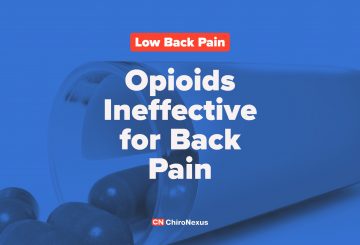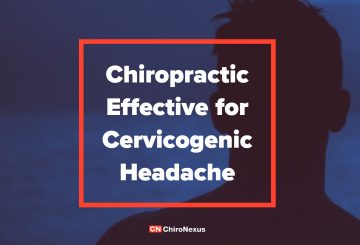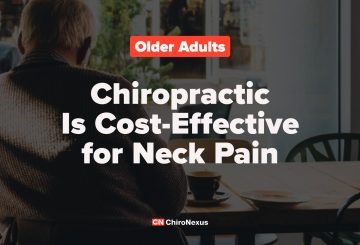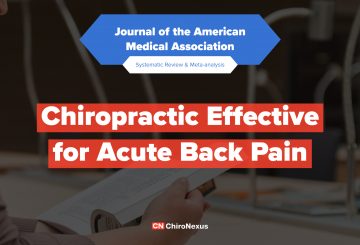Auto Added by WPeMatico
-
7 f 2018

“
A new study just published in the Journal of the American Medical Association finds that opioids are not an effective solution for chronic pain. In this article, researchers from the University of Minnesota studied 240 patients who had chronic back, hip, or knee arthritis pain. Half of the study subjects received opiates; the other half received non-opiate pain medications. Patient progress was evaluated at 3-months, 6-months, 9-months, and one year. The study found:”- There was no difference in pain-related function between the two groups.
- At 12 months, the nonopioid patients had less pain than did those who received opiates.
- “The opioid group had significantly more medication-related symptoms over 12 months than the nonopioid group”
“Among patients with chronic back pain or hip or knee osteoarthritis pain, treatment with opioids compared with nonopioid medications did not result in significantly better pain-related function over 12 months. Nonopioid treatment was associated with significantly better pain intensity, but the clinical importance of this finding is unclear.”
Previous research has found that about 20% of patients with musculoskeletal pain are prescribed narcotic pain medications for their symptoms, and another recent study found that 36% of people who overdosed from opiates had their first opioid prescription for back pain. Another recent study found that chiropractic patients are less likely to use opiates for their pain than are medical patients. From this research, it seems clear that it’s risky to prescribe opiates for musculoskeletal pain. Chiropractic care is a proven safe and effective approach for both chronic and acute back pain. Krebs EE, Gravely A, Nugent S, Jensen AC, DeRonne B, Goldsmith ES, Kroenke K, Bair MJ, Noorbaloochi S. Effect of Opioid vs Nonopioid Medications on Pain-Related Function in Patients With Chronic Back Pain or Hip or Knee Osteoarthritis Pain: The SPACE Randomized Clinical Trial. JAMA. 2018 Mar 6;319(9):872-882. doi: 10.1001/jama.2018.0899. -
7 f 2018

“
”According to the World Health Organization (WHO), headache pain is “extremely common,” with headache disorders—which are characterized as head pain that is repeated in nature—afflicting as many as one in 20 individuals on a daily or almost-daily basis. An additional one in seven people deal with the king of all headaches: migraines.
Another type of headache which can create an amazing amount of throbbing discomfort is a cervicogenic headache. Defined by the American Migraine Foundation as a “secondary headache” whose cause originates somewhere in the neck area even though it presents itself in the head, some research studies have found that these particular headaches tend to respond rather well to chiropractic treatment sessions.
For instance, BMC Research Notes published the results of a single-blinded randomized control trial conducted in Norway which involved 19 individuals between the ages of 18 and 70 who suffered from cervicogenic headaches. Each subject was assigned to one of three groups for a length of 17 months. The first group received actual chiropractic spinal manipulative therapy utilizing the Gonstead Method. The second group received sham chiropractic manipulations, and the third group served as a control and was simply asked to continue with their current treatment regimen, which did not include any type of manual intervention whatsoever.
Upon conclusion of the study, only 12 of the original 19 participants remained, due to either drop outs or the subject being excluded once randomization occurred. However, of these remaining individuals, those assigned to receive actual spinal manipulation reported a reduction in the number of headaches experienced both during the treatment regimen and at follow-ups conducted six months and one year post-treatment. This was particularly notable when compared to individuals assigned to the control group who reported no change in their cervicogenic headache frequency during or post-study.
While this is a rather small sample size, highlighting the need for more research to be conducted in this area, the study’s findings suggest that, for patients struggling with cervicogenic headaches, chiropractic treatment is definitely better than no treatment at all. This is true both short and long term as positive effects are likely to remain long after the sessions have ceased.
Additionally, although headache pain is among one of the most common pains experienced by adults worldwide, that doesn’t mean that people must simply manage their way through it. By engaging in regular chiropractic care, some headaches can be effectively treated at the source. Cervicogenic headaches are one of them, making this treatment method beneficial for patients seeking a reduction in head pain, and an increase in life satisfaction.
-
Cervicogenic Headache. (October 24, 2016). American Migraine Foundation.
- Chaibi A, Knackstedt H, Tuchin PJ, Russell MB. Chiropractic spinal manipulative therapy for cervicogenic headache: a single-blinded, placebo, randomized controlled trial. BMC Research Notes 2017;10:310.doi:10.1186/s13104-017-2651-4
-
-
15 f 2018

“
The National Highway Traffic Safety Administrations reports that more than two million people are injured every year in auto-related accidents involving either a passenger vehicle, large truck, or motorcycle. Furthermore, that number appears to be climbing at an alarming rate, increasing more than five percent between 2014 and 2015 alone. Certainly, being involved in this type of incident can have long-lasting effects. For instance, one study published in the journal Psychosomatic Medicine found that “a substantial minority” of subjects questioned reported experiencing anxiety when traveling in a motor vehicle post-accident, with 10 percent developing post-traumatic stress disorder (PTSD), a condition that, in some cases, plagued them for years. Well, another recently published study has found that being in a car crash can also result in long-term physical ramifications as well. Specifically, it discovered that back pain can linger or appear long after the vehicle has been fixed and the debris has been cleaned out of the roadway. In April of 2017, the European Spine Journal presented a study involving 789 adults, all of whom reported experiencing mild low back pain or no pain at all. Upon entering the study, each person was asked whether or not he or she had been in a motor vehicle accident resulting in low back pain, making note of whether their level of pain increased, decreased, or stayed the same six and 12 months down the road. Approximately 74.8 percent of the participants responded at the six month mark, with 64.5 percent providing input at 12 months. Of those who did respond, researchers noticed a positive correlation between those who had previously been involved in an auto accident and the incidences of low back pain at a later date. In other words, having a car crash in your past may increase your risk of back pain in the future. This is partially why being assessed right after a car wreck is so critical. While this is relatively standard when it comes to auto injuries that can be seen or easily felt, damage done to the musculoskeletal system isn’t quite so visible or easy to pinpoint, which also makes it easier to ignore. Educating patients is the first step to helping them resolve any subsequent back issues. The second step is to regularly ask them whether they’ve been involved in a crash, no matter how small. If they have, addressing that issue first and foremost can keep their quality of life from being compromised months, years, or even decades later. References”- Mayou R, Tyndel S, Bryant B. Long-term outcome of motor vehicle accident injury. Psychosomatic Medicine 1997;59(6):578-84.
- Nolet PS, Kristman VL, Côté P, Carroll LJ, Cassidy JD. The association between a lifetime history of low back injury in a motor vehicle collision and future low back pain: a population-based cohort study. European Spine Journal 2017;doi:10.1007/s00586-017-5090-y
- Traffic Safety Facts. (August 2016). 2015 Motor Vehicle Crashes: Overview. National Highway Traffic Safety Administration.
-
7 f 2018

“
”Johns Hopkins Medicine defines pain as “an uncomfortable feeling that tells you something may be wrong.” Depending on its cause, this feeling can range from being mildly annoying to absolutely debilitating in nature, potentially preventing a person from having any quality of life whatsoever. Additionally, some pains are constant and steady, whereas others tend to come and go.
Regardless of the type, intensity, and consistency of the pain, at some point in our lives, we all experience this feeling in one form or another. However, whether or not we’re able to effectively handle it is largely determined by our individual pressure pain thresholds. In other words, the higher our thresholds, the less impact these pains have on our lives, and one fairly new study has found that chiropractic may just increase that limit.
In December of 2016, Chiropractic & Manual Therapies published a piece of research which set out to determine what effect, if any, spinal manipulation therapy (SMT) had on pressure pain threshold. Individuals were recruited from Murdoch University campus in Western Australia and, ultimately, 34 subjects ranging in age from 18 to 36 qualified for inclusion. Twenty of the participants were male, with the remaining 14 being female, all of whom were assessed at the beginning of the study and declared asymptomatic.
Using an algometer with a 1cm2 rubber probe, the participants’ deep mechanical pain sensitivity was assessed multiple times at four different sites on the body (calf, lumbar, scapula, and forehead) by asking each one to indicate the point in which the pressure turned into pain. The average of the second and third recordings was used as a baseline.
Once the initial data was recorded, each participant was then subjected to a high-velocity, low-amplitude spinal manipulation using the hypothenar mammillary push while the subject lay on his or her side. Furthermore, the thrust was aimed at the portion of the participants’ spine located between the L5 and S1 vertebrae. Upon completion, the pressure pain threshold was collected again, and then again at 10, 20, and 30 minutes after the conclusion of the treatment session.
Researchers found that, after engaging in just one session of SMT, subjects reported increases in pressure pain threshold in the calf and lumbar spine areas, with no notable reduction in the scapula or forehead. Additionally, the thresholds that did increase did so at a higher rate on the right side of the participants’ bodies than on the left.
This study shows promise for patients dealing with chronic pain issues as chiropractic adjustments seem to provide an instantaneous reduction in pain. Further research with a larger group of test subjects is warranted.
Dorron SL, Losco BE, Drummond PD, Walker BF. Effect of lumbar spinal manipulation on local and remote pressure pain threshold and pinprick sensitivity in asymptomatic individuals: a randomised trial. Chiropractic & Manual Therapies 2016;24:47.10.1186/s12998-016-0128-5 What is Pain/Types of Pain Treated? Johns Hopkins Medicine: Blaustein Pain Treatment Center. -
31 f 2018

“
Although most people dream of being financially secure in their older years, sadly, this isn’t turning out to be the case. In fact, the National Council on Aging reports that more than 25 million of our nation’s 60+ year olds are considered “economically insecure” as they’re living at or below the federal poverty level, which is just under $30k a year. Ultimately, this often means having to decide which bills get paid first, which ones don’t get paid at all, and what things they can go without. Sometimes, looking after their health doesn’t make the cut. Yet, one study has found that chiropractic can be a cost effective treatment option for older adults struggling with the all-too common issue of chronic neck pain. The study was funded by the National Institute of Health and Health Resources and Services Administration and, in it, the researchers set out to determine the cost-effectiveness of three different treatment options: home exercise and advice (HEA), HEA combined with spinal manipulative therapy (SMT), and HEA combined with supervised rehabilitative exercise (SRE). Results were published in the November 2016 edition of The Spine Journal and, among those studied were 241 individuals aged 65 or older in the Minneapolis, Minnesota suffering with chronic mechanical neck pain. To be included, the participants had to be over a “3” on a 0-10 pain scale for three months or more, and the pain had to be accompanied by stiffness or tenderness in the cervical spine. Once accepted, participants were assigned to one of the three treatment groups for a total of 12 weeks. The HEA-only group received four one-hour sessions in which they were instructed as to which exercises would help and how to self-manage the pain. The HEA + SMT group received the same, plus up to 20 sessions with a chiropractor. The HEA + SRE group had the same four instruction sessions, plus 20 one-hour sessions working on neck exercises with an exercise therapist. The costs of the treatments and their effectiveness were followed for one year, with data calculations occurring at the one, three, and six month marks, as well as at the end of the study. Based on the results, researchers determined that SMT and HEA combined “resulted in the greatest reduction of neck pain and disability, and the most gains in QALYs” (quality-adjusted life years). Furthermore, this combined treatment method was five percent lower in cost than HEA alone and 47 percent lower than SRE and HEA combined when taking into account both direct and indirect costs. Thus, chiropractic can be part of an affordable, yet effective treatment plan for this segment of the population. Leininger B, McDonough C, Evans R, Tosteson T, Tosteson AN, Bronfort G. Cost-effectiveness of spinal manipulative therapy, supervised exercise, and home exercise for older adults with chronic neck pain. The Spine Journal 2016;16(11):1292-1304.”Economic Security for Seniors Facts. (n.d.). National Council on Aging.
-
23 f 2018

“
”Statistics compiled by the American Chiropractic Association (ACA) tell us that back pain affects a large majority of the population, with roughly 80 percent of people enduring at least one back-related issue during the course of their lives. In fact, there are currently 31 million people in the U.S. alone dealing with chronic, daily back pain.
With these types of numbers floating around, chiropractic patients may feel as if their back pain is inevitable, making the seeking of treatment futile. However, one recently released study review says otherwise, that is, as long as the treatment plan includes chiropractic.
The Journal of the American Medical Association (JAMA) published a systematic review and meta-analysis conducted by 10 medical professionals from medical centers, universities, and healthcare systems across the U.S. The main question this group set out to answer was, “Is the use of spinal manipulative therapy in the management of acute (≤6 weeks) low back pain associated with improvements in pain or function?”
After taking a more in-depth look at 26 different randomized clinical trials occurring between January of 2011 and February of 2017, all of which involved spinal manipulative therapy (SMT), this set of researchers found that, in 15 of the studies, this particular treatment option provided “statistically significant benefits” for the 1,711 patient subjects when it came to lowering their levels of pain. In this same group of studies, almost half of the cases (12) also found major positive effects in regard to the level of function of the 1,381 participants when compared to sham chiropractic or other treatment methods.
It should also be noted that, while 50 to 67 percent of the participants in these studies reported experiencing headaches, muscle stiffness, or even increased pain after SMT, no serious adverse events occurred. This helps confirm chiropractic’s safety, making it a viable method of treating acute back pain episodes quickly and effectively.
These findings are extremely important as another statistic offered by the ACA is that approximately 50 percent of the working population has struggled with some type of back-pain issue in the previous 12 months. Thus, one very effective way to keep them earning an income and supporting their families in a manner that treats the symptoms and cause of their pain is regular and consistent chiropractic care.
This saves them both time off work and money due to unnecessary (and usually costly) medical bills, enabling them to spend both on the things they enjoy instead.
- American Chiropractic Association. (n.d.) Back Pain Facts and Statistics.
- Paige NM, Miake-Lye IM, Booth MS, Beroes JM, Mardian AS, Dougherty P, Branson R, Tang B, Morton SC, Shekelle PG. Association of Spinal Manipulative Therapy With Clinical Benefit and Harm for Acute Low Back Pain: Systematic Review and Meta-analysis. 2017;317(14);1451-1460. doi:10.1001/jama.2017.3086
